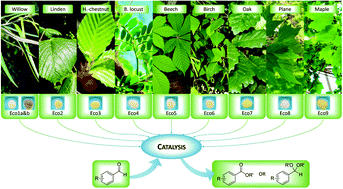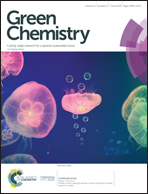Woody species: a new bio-based material for dual Ca/Mg catalysis with remarkable Lewis acidity properties†
Abstract
Advances in green catalysis have promoted the development of ecocatalysis encountered in most of the main transformations of organic chemistry. Taking advantage of the remarkable capacity of certain plants to hyperaccumulate transition metals into shoots or roots, we have addressed the direct use of metals derived from contaminated plant wastes as supported Lewis acid catalysts, coupling agents, oxidative and reducing catalysts in green chemistry. This approach constituted the first example of chemical catalyst based on phytotechnologies. Herein, we show that the concept can be extended to common and abundant plant species that are surprisingly appropriated for chemical catalysis. We present that willow, birch, plane and linden trees can be used to produce bio-based and original Lewis acid catalysts. The catalytic potential of these species will be illustrated through two representative transformations, acetalisation and oxidative esterification. Thanks to their original polymetallic composition, ecocatalysts provided better results compared to classical metal chlorides such as MgCl2, CaCl2 or ZnCl2. This illustrates the interest of the ecocatalysis and is incorporated within the green and sustainable chemistry concept.



 Please wait while we load your content...
Please wait while we load your content...